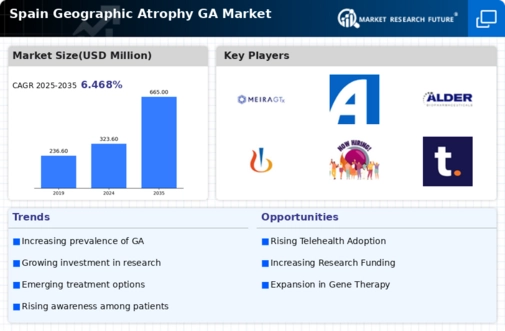Aging Population Dynamics
The demographic shift towards an older population in Spain appears to be a primary driver for the geographic atrophy-ga market. As individuals age, the risk of developing age-related macular degeneration (AMD) increases, leading to a higher incidence of geographic atrophy. Current statistics indicate that approximately 20% of individuals over 75 years old are affected by AMD, which suggests a growing patient population. This trend is likely to escalate the demand for effective treatments and management strategies within the geographic atrophy-ga market. Furthermore, the increasing life expectancy in Spain, projected to reach 86 years by 2030, may further amplify the prevalence of geographic atrophy, thereby creating a robust market environment for therapeutic interventions.
Rising Awareness and Education
There appears to be a growing awareness regarding eye health and the implications of geographic atrophy in Spain. Public health campaigns and educational initiatives are increasingly focusing on the importance of early detection and treatment of AMD and its associated conditions. This heightened awareness may lead to more individuals seeking medical advice and screening, thereby increasing the patient base for the geographic atrophy-ga market. Recent surveys indicate that nearly 60% of the population is now aware of AMD, a significant increase from previous years. As awareness continues to rise, it is likely that more patients will be diagnosed and treated, driving demand for innovative therapies and management solutions in the geographic atrophy-ga market.
Regulatory Support for New Therapies
Regulatory bodies in Spain appear to be increasingly supportive of the development and approval of new therapies for geographic atrophy. The streamlined approval processes and incentives for innovative treatments may encourage pharmaceutical companies to invest in this area. Recent regulatory changes have reduced the time required for clinical trials and expedited the review of new drugs, which could lead to faster access to therapies for patients. This supportive regulatory environment is likely to stimulate growth in the geographic atrophy-ga market, as it fosters innovation and encourages the introduction of new treatment options. As a result, patients may benefit from a wider array of therapies designed to address geographic atrophy.
Healthcare Infrastructure Improvements
Spain's ongoing enhancements in healthcare infrastructure are likely to bolster the geographic atrophy-ga market. The government has been investing significantly in healthcare facilities and services, aiming to improve access to eye care for the aging population. Recent reports indicate that healthcare spending in Spain has increased by approximately 5% annually, which may facilitate better diagnosis and treatment options for geographic atrophy. Enhanced training for healthcare professionals and the establishment of specialized eye care centers could lead to earlier detection and intervention, ultimately benefiting patients. This improved infrastructure is expected to create a more favorable environment for the geographic atrophy-ga market, as it aligns with the growing need for effective management of age-related eye diseases.
Investment in Research and Development
The geographic atrophy-ga market in Spain is likely to benefit from increased investment in research and development (R&D) focused on innovative treatment options. Pharmaceutical companies and research institutions are actively pursuing new therapies aimed at slowing the progression of geographic atrophy. Recent data suggests that R&D spending in the ophthalmology sector has risen by approximately 10% annually, reflecting a commitment to addressing unmet medical needs. This investment may lead to breakthroughs in drug development and novel therapeutic approaches, which could significantly enhance the treatment landscape for geographic atrophy. As new therapies emerge, the geographic atrophy-ga market is expected to expand, offering patients more effective options for managing their condition.




















Leave a Comment